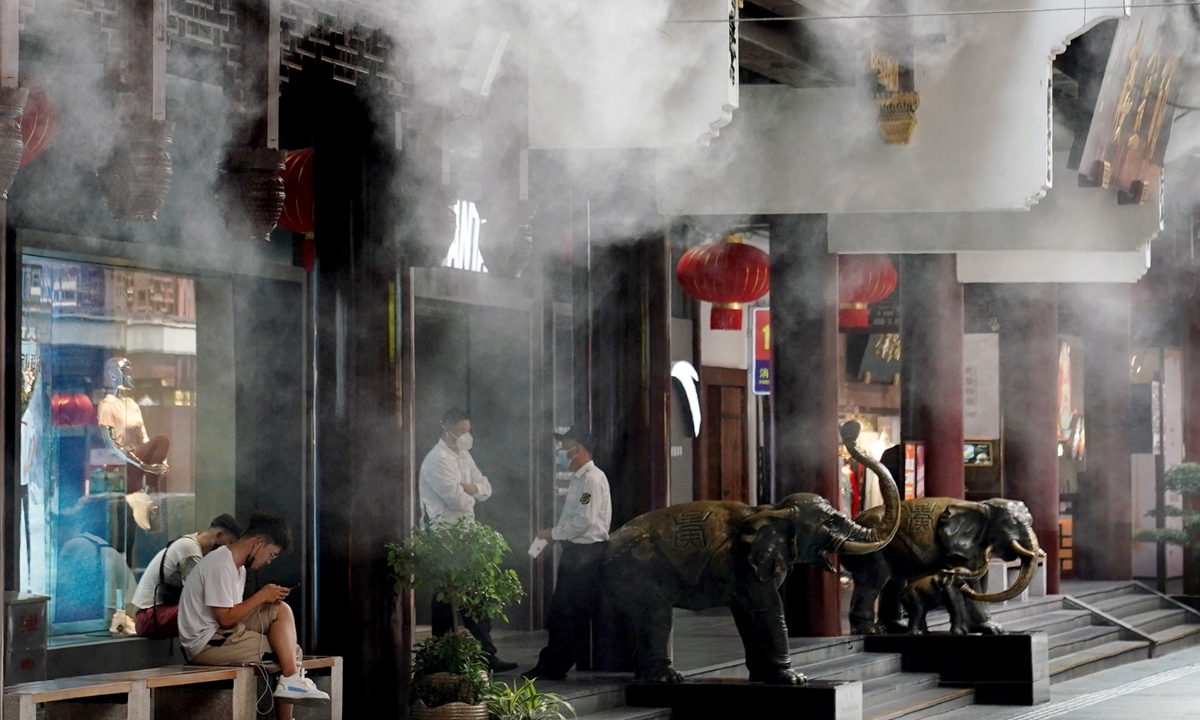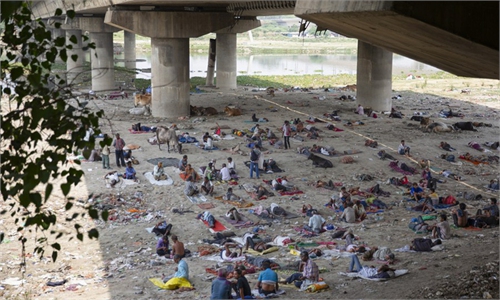Scorching heatwaves roast China with 900m affected, to persist into August, as authorities, industries brace for intense heat

Shops in Shanghai's Yuyuan Garden use misty spray heat prevention devices on July 14, 2022. Shanghai has issued its highest alert for extreme heat for the third time this summer as sweltering temperatures repeatedly tested records this week. Photo: Xinhua
Hot air has blanketed many parts of China including Shanghai, Southwest China's Sichuan Province and East China's Jiangsu and Zhejiang provinces, affecting more than 900 million people and over half of the national territory as of this week, with many cities in the grip of a heatwave for more than a month and temperatures soaring to above 44 C, according to the meteorological authority.
However, meteorologists warned that climate change will lead to global heatwaves that are longer, more extreme, more frequent and that affect more people, and this will become a new normal even if we achieve global climate targets.
The heatwave in 2022 has come earlier, and the average temperatures for June have hit the highest since 1873, Sun Shao, a senior researcher at the National Climate Center affiliated with the China Meteorological Administration, told the Global Times on Thursday.
Since June, China has experienced this year's first regional hot weather, which has seen 71 national weather stations break records with the highest temperature recorded at 44.2 C in Lingshou, North China's Hebei Province, according to the National Climate Center.
Sun Shao predicted that this weekend, the temperature in parts of the Yangtze River, Sichuan Basin, and south of Xinjiang is expected to hit 40 C and above. In the next 30 days, temperatures in most parts of China will be higher than usual with temperatures in many provinces including Zhejiang, Anhui, Henan, Hubei and Sichuan possibly rising by 1 or 2 C.
On Thursday, three of the 10 most viewed topics on Weibo were related to heatwaves in China, with some joking that they could grill meat perfectly in the heat, and some posting photos of frying eggs on the sidewalk and frying steaks on their balconies.
A video by the short-video official account of youth.cn Qingfengxia showing an ant that died a few seconds after being placed on the sidewalk in Danyang, East China's Jiangsu Province, was widely circulated on social media. The land surface temperature in Danyang reached 65 C on Thursday.
Some cities in southern China have been gripped by the dual challenges of heatwaves and sporadic clusters of COVID-19 infections. For the third time this summer, Shanghai issued a red alert, the highest in China's four-tier, color-coded weather warning system for extreme heat on Thursday, as temperatures were expected to hit 40 C and above. The financial hub witnessed the city's highest temperature on record on Wednesday at 40.9 C.
Meanwhile, from July 3 to Wednesday, Shanghai reported 480 COVID-19 infections and 19 residential communities on Thursday were classified as medium-risk zones, according to the local health authority.
Nine districts carried out nucleic acid testing from Tuesday to Thursday this week. A nucleic acid test worker surnamed Gu in Minhang district told the Global Times on Thursday that after days of nine-hour shifts outdoors every day, one of his colleagues collapsed on Wednesday while checking residents' health information and was immediately sent to hospital for treatment.
Many local residents have brought them food and other supplies, and some communities also prepared ice blocks for them to cool down with, Gu said, adding that he received more supplies on Thursday, including towels, water, snacks and tiger balm.
While Gu's colleague soon recovered, reports of heat stroke have been increasing in various cities in the past days, with at least one death reported by a hospital in Southwest China's Sichuan Province and two dozen patients hospitalized in southern cities.
Sun explained that the worst heat wave in China has come against a backdrop of increasing climate instability caused by global warming, and typhoon Chaba has also contributed to it as a stable warm high pressure area formed after Chaba left.
In view of the intensification of high temperatures in recent years, Sun said that the identification criteria of extreme high temperature events need to be further adjusted, as the criteria developed based on historical observations cannot meet the new normal of high temperature situations in China.
Dev Raturi, an Indian actor and entrepreneur who has been living in China for 16 years, told the Global Times on Thursday that the scorching weather in China in the last few days reminded him of being back in India, but the sun's rays in India are much stronger. He currently lives in Xi'an, Northwest China's Shaanxi, where the city's temperature hit 40 C last week.
An intense heatwave has scorched India from March, with temperatures hitting a record 49.2 C in parts of Delhi in May, according to BBC. Photos circulated on social media showed that some Indian people walking on the street found their shoes had become stuck in the melted tar.
Globally, hot weather has swept much of Europe this week, with France, Britain and Spain on high alert over wildfires and public health, according to media reports.
In August, air temperatures in most inland areas are expected to remain high. The average temperature in Europe, west Asia, southern and eastern North America, southern parts of South America, and northern Australia is likely to be 1-2 C higher than normal, according to Sun.
Driven by climate warming, extreme temperatures will be a new normal, Sun said. The possibility for unprecedented extreme events is also likely to be higher, and extreme heatwaves are also expected to happen in a shorter recurrence interval, with heatwaves that historically occurred once every five years now likely to happen once every one to two years, Sun said.
In China, Sun's climate projections show that the frequency for temperature extremes in southern Hebei, western Shandong, western Jiangsu, and western Guangdong will rise sharply in the next 30 years, which may lead to unprecedented climate risks.
Even under the low emission scenario - for example, achieving the 2 C warming target set by the Paris Agreement and carbon neutrality by 2060 - the annual average number of hot days in eastern China will rise from 9.3 days to 16.4 (±1.8) days, while 10 percent of the national territorial area will be exposed to more than 30 days of high temperatures, Sun said.
Power grid and crops
China's daily power generation has risen rapidly since the beginning of summer, triggered by power consumption growth in key industries and rising temperatures, Li Yunqing, director of the operation bureau with the National Development and Reform Commission, said on Thursday. He said power generation amounted to 27.854 billion kWh and the maximum power load reached 1.22 billion kWh, both hitting record highs on Tuesday.
We will make every effort to ensure energy supply during the summer peak demand period to ensure energy demand for people's livelihoods and economic development, he said, noting that so far it has been stable.
Different provinces including East China's Zhejiang and Anhui provinces, Northeast China's Liaoning and Heilongjiang provinces and South China's Guangdong Province announced plans to restrict enterprises with high power consumption, as well as those enterprises slated for elimination in the industry list.
A manager from a textile company based in Changzhou, East China's Jiangsu Province, told the Global Times that electricity is the biggest cost for textile enterprises except for raw materials, which is probably a little higher than labor costs, but this year's high temperature has had little impact on the factory's operations, as peak electricity prices were implemented last year and textile orders have seen a large drop this year.
According to a forecast from the China Electricity Council, power supply and demand will be generally balanced during the peak summer season, but the peak demand will be tight, and is predicted to be tight for East China, Central China, and South China.
Some rice farmers worried that the high temperature may threaten their crops.
Continuous high temperatures and droughts have had an impact on the growth of rice, Zhang Wei, an owner of a farmland in Danyang, Jiangsu Province told the Global Times on Thursday. His farmland has 1,200 mu of rice with an annual output of 750 tons.
"The summer grain is harvested, but the problem now is the rice. If the drought continues, the yield could be cut by 20 percent," he said.
The hot weather also posed a threat to pigs, with firefighters in several cities in Jiangsu and Zhejiang having to spray water on pigs that showed signs of heat stroke while being transported on highways.
The temperature is high, but we have different cooling machines to cool the pig house, and so far it's fine, Li Yunlong, an owner of a pig farm in Neiqiu, North China's Hebei Province, told the Global Times, adding that there have been no electricity power shortages.

